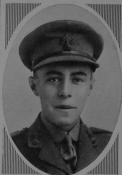
|
The King's School Canterbury |
Roll of Honour |
| 2nd Lieutenant Geoffrey Arthur PUGH | |
|
26th (Bankers) Battalion Royal Fusiliers (City of London Regiment) Date of birth: 25th February 1896 Date of death: 7th October 1916 Killed in action aged 20 Commemorated on the Thiepval Memorial Panel and Faces 8C, 9A and 16A |

|
| He was born at St John's Wood on the 25th of February 1896 the only son of Arthur James Pugh, wool merchant, and Marion Louise Hora (nee Dowse) of 6 Loveday Road, Ealing. He was christened at St Mark's Church, Hamilton Terrace, Marylebone on the 7th of June 1896. He was educated at Glencourse School in Eastbourne and at the King's School Canterbury from September 1910 to June 1914 where he was a member of the Officer Training Corps for two years. In 1913 he matriculated for London University and became an electrical student. Following the outbreak of war he enlisted at Epsom as Private 1957 in the 18th (Service) Battalion Royal Fusiliers (City of London Regiment) (1st Public Schools), University and Public Schools Corp on the 19th of October 1914. At a medical examination, which was held on the same day, it was recorded that he was five feet seven inches tall, that he weighed 122lbs and that he had a fresh complexion, green eyes and dark hair. He embarked with his battalion at Folkestone on board the SS "Princess Victoria" at 8.15am on the 14th of November 1915 and arrived off Calais at 11.15am where they were unable to land due to enemy mines and so were diverted to Boulogne where they landed in the early afternoon. While he was in France he applied for a commission on the 12th of March 1916 and returned to England for officer training on the 24th of March. He was commissioned a 2nd Lieutenant in the Special Reserve of Officers on the 5th of August 1916 and was attached to the 26th Battalion Royal Fusiliers (City of London Regiment). On 7 October 1916 the 26th Battalion Royal Fusiliers was detailed to attack Bayonet Trench, in front of the village of Le Barque. The battalion was gathered in their assembly trenches at zero hour (1.45pm). A and B Companies were in the vanguard with C and D Companies in support of the attack. The British artillery poured heavy fire onto the German positions and the battalion went forward in good order. Early on they came under very heavy machine gun fire from German machine guns which had been moved forward to avoid the artillery. Although the Fusiliers suffered severe casualties they managed to get within 50 yards of their objective but were forced to go to ground and dig in about 350 yards from where they had started. By dusk after hours of digging they had dug a continuous line. All company officers had become casualties and most of the men were by now being commanded by the surviving NCOs. During the 8th a communication trench was dug and although snipers were in evidence, the expected German counterattack did not materialize. The battalion was relieved that evening. His father received the following telegram dated the 18th of October 1916: - "Deeply regret to inform you that 2nd Lieut. G.A. Pugh 26 Royal Fusiliers was killed in action October 7th. The Army Council express their sympathy." A brother officer wrote:- "In all that trying time of shelling he had been cheerful and of the very greatest use to me in every way." The Commonwealth War Graves Commission record his date of death as being the 10th of October 1916. So many men from the battalion were missing in action during this period that they were declared killed in action on the 10th of October although all other available evidence shows that Geoffrey Pugh in fact died on the 7th of October 1916. |
|
| Langley House |
Back